This, apparently, is a physical representation of a digital (video game) representation of a Coke can. The artist (Ashley A on Flickr) writes:
While playing Bad Dudes, I killed a ninja, who upon dying dropped a 5 x 9 pixel powerup; that powerup, despite its incredibly small size, was instantly recognizable as a Coca Cola can. It blew my freaking mind!!! I was in love.
This particular image is the first iteration in a series exploring this super-reduced icon of an Icon (with a capital “I”) in various media.
Via Not A Real Thing.
Posted Under:
Artists,
Things/Thinking
This post was written by Rob Walker on April 29, 2010
Comments Off on Digital representation, made physical
This was one of my favorite column topics ever. I still see donks around town here in Savannah, and other points south. I don’t see as many with exciting brand-inspired themes, though. Then yesterday I saw this excellent Cap’n Crunch donk on Flickr, I believe taken in Little Rock:
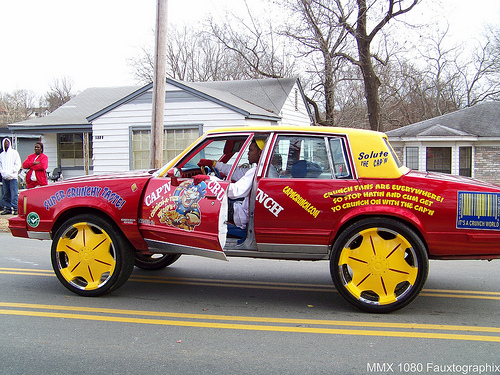
Pic by 1080Graphixdesign
Then after poking through some Flickr pools, this from Greenville, AL:
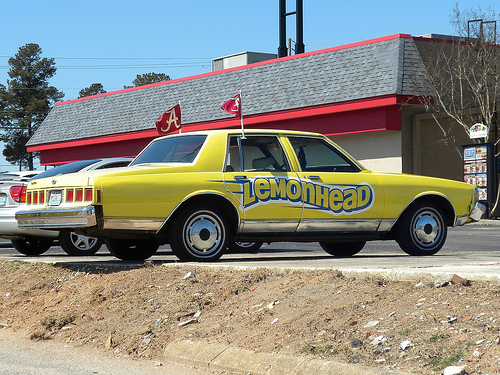
Pic by Katie and Joe
Great stuff.
Posted Under:
The Designed Life,
Update
This post was written by Rob Walker on April 29, 2010
Comments Off on Another random consumed update: Themed-out donks
Recently I had a column about object utility using the ax, through history, as an example. Recently this super-functional ax came to my attention:
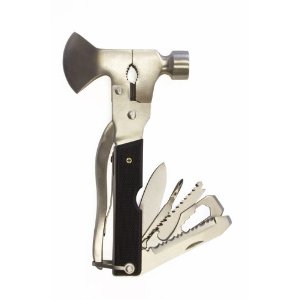
This reminds me of the kind of excess of functionality that characterizes certain tech gizmos: That is, it’s not so much about how you’ll use all the functions, it’s more about signally (largely to yourself) about all the functions you MIGHT and COULD use, at some point.
Posted Under:
Update
This post was written by Rob Walker on April 28, 2010
Comments Off on Consumed Update: Ax functionality
Given my interest in Things That Look Like Other Things, it’s inevitable that some would pop up in this series.
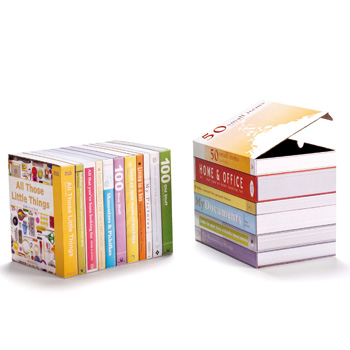
Boxes That Look Like Books. Click for more.
Bookshelf blog reports: “Designed by Peleg Design. Printed cardboard boxes for elegant storage on book shelves.”

Shelf That Looks Like A Book. Click for more.
Note the title of the bottom “volume.” Bookshelf blog notes that it is actually “a small shelf with the appearance of a book.”
Posted Under:
Products,
The Designed Life
This post was written by Rob Walker on April 28, 2010
Comments Off on Books, the idea, cont’d: This is not a book.
I’m still poring over the delightful Bookshelf blog, but here’s a little bit to add to this occasional series of posts.

By Hans Feldman
Bookshelf says: “‘Bookshelves’ is a 5-panel, life-size photograph of Feldmann’s own bookshelves at his home in Düsseldorf.”
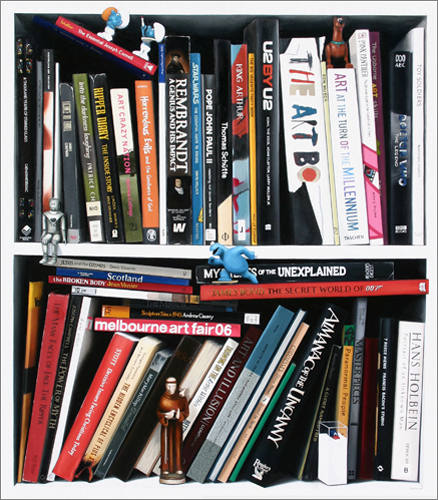
"Alasdair Macintyre," by Victoria Reichelt; click for more.
Apparently this is an oil on canvas piece, one several made by Victoria Reichelt. Bookshelf quotes her:
While some of these bookshelf paintings are of random books, I’ve recently done a series that are portraits of people. So I’d go to their houses and photograph their bookshelves and then make paintings from the photos as a way of telling the viewer about the person.
She also made this series of color-grouped books, which I think are pretty stunning:
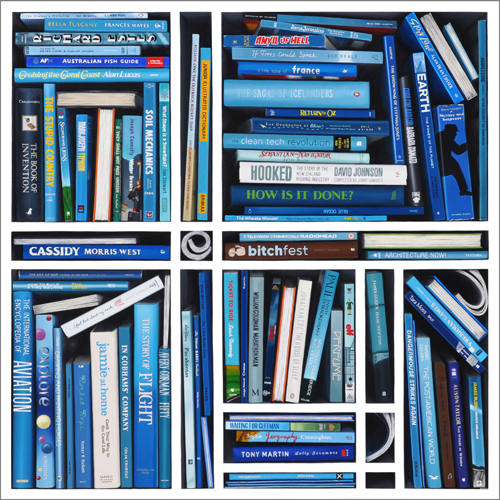
"Blue Ocean," by Victoria Reichelt, click for more.
Posted Under:
Artists
This post was written by Rob Walker on April 27, 2010
Comments Off on Books, the idea, cont’d: Spines as art
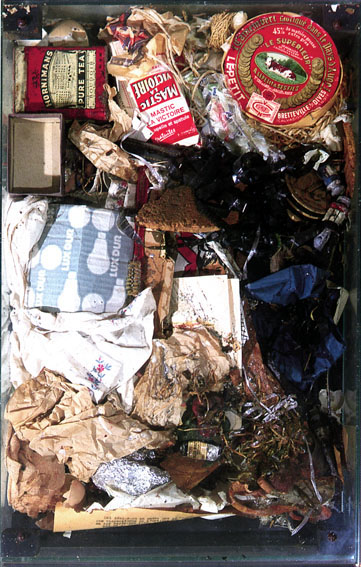
By Arman. Click for more.
Via EverydayTrash. This is household trash, in a glass box, photographed by a French artist named Arman. More info here and here.
Mildly related: Justin Gignac’s garbage in a box.
This post is part of a series.
- Teaching Youngsters How to Read Advertising: “The initiative seeks to educate children in grades four through six — tweens, in the parlance of marketing — about how advertising works so they can make better, more informed choices when they shop or when they ask parents to shop on their behalf.” Get an “ad-ucation” at admongo.gov. Ugh.
- Priest’s “sermonettes” offer daily dose of spirituality through the iPhone: “There are now hundreds of religious-themed iPhone apps. There’s the Azan Alarm Clock, with Islamic prayer times. There’s the Buddha Buddy, allowing you “to access the wisdom of the Buddha conveniently on your iPhone.” There’s the Daily Tao, the Daily Jesus, the Daily Krishna, the Daily Kabbalah and the Daily Joan of Arc. There’s even the Mobile Atheist, with an inspirational “freethought” of the day.”
- Play’s the Thing: “A new book argues that play may be the primary means nature has found to develop our brains.”:
- Why People Are So Cynical: “How do people come to believe that others are so much less trustworthy than themselves?” Via Mindhacks.
- Fruit With an Obnoxious Streak Stars on YouTube: The business of Annoying Orange.
- Geekend 2010: Want to present at Geekend in Savannah? Submit your idea here. (Organizer is an acquaintance; did a solid job last year.)
These links compiled via delicious, and repurposed here with plug-in Postalicious. Not enough stuff? Not the stuff you wanted? Try visiting unconsumption.tumblr.com, murketing.tumblr.com, and/or the Consumed Facebook page.
Posted Under:
Non-Daily Linkpile
This post was written by Rob Walker on April 27, 2010
Comments Off on Linkpile

Andrew C. passes along this interesting item from Coolhunting. The paint company Delux, as I understand it, is setting out to colorfully paint “dreary” buildings around the world. The Delux site for the project, which is called Let’s Colour, says it will “work with communities all over the world.”
While there is clearly a murketing element to this, I’m cautiously impressed by the idea. The project’s — very colorful! — blog is here.

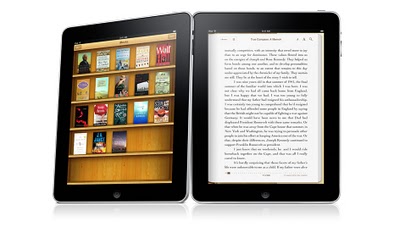
Via Bookshelf Blog, click for more.
Here via the Bookshelf blog are two items of note. Above, the iBookshelf app, available for iPhone or iPad, as I understand it. Below, an iPhone bookshelf skin.
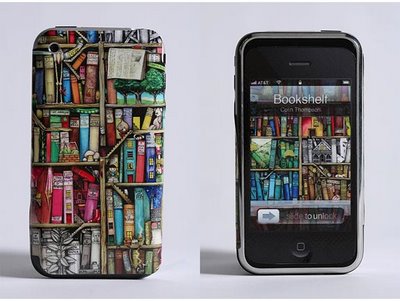
Via Bookshelf Blog. Click for more.
I assume — if you’re at all interested in this series of posts — you’ve already heard about, read, critiqued, etc the Ken Auletta iPad piece in The New Yorker. Can I possibly add anything? Not really, but in relation to this series, I did ponder this aside:
There are now an estimated three million Kindles in use, and Amazon lists more than four hundred and fifty thousand e-books. If the same book is available in paper and paperless form, Amazon says, forty per cent of its customers order the electronic version. Russ Grandinetti, the Amazon vice-president, says the Kindle has boosted book sales over all. “On average,” he says, Kindle users “buy 3.1 times as many books as they did twelve months ago.”
Obviously buying books isn’t the same thing as reading books. It’s quite plausible to me that e-books, being rather easy to buy, will set a new standard for the distribution of paid-for and unread words. Does it matter? My mixed feelings are too obvious to bother expressing.
But as it happens, I was sorting out the physical books in my office the other day, and trying to estimate the percentage of books I own but haven’t read. There are many reasons for this. Let’s just set aside the stuff that I have no intention of reading but was sent to me be a publicist, or don’t want to read but might have to at some point for professional reasons. There are plenty of the books I own that I really do intend to read — but I “haven’t found time.” How many? What percentage? And would such titles pile up more quickly on ebook “shelves”? I think for me they would.
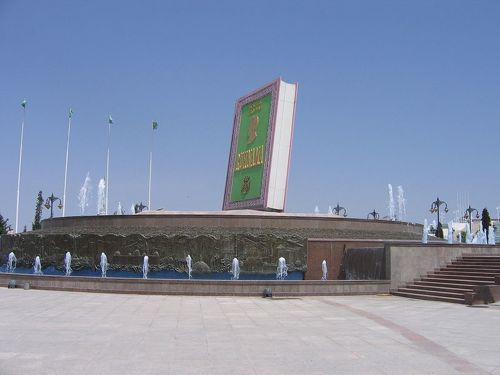
Mr. Portigal (thanks!) points out this Metafilter post that I’d missed:
In the capital of Turkmenistan stands an enormous statue of a book. Every evening at 8PM, the statue swings open and a recently deceased dictator’s magnum opus, the Ruhnama, is broadcast throughout the square while a video from within the statue shows his image.
The post links to a documentary maybe by Finnish filmmakers and available on YouTube in 10 parts. I did not watch the whole thing. In this part, however, at about the 4:35 mark, there’s some twilight / nighttime footage of the book swinging open. I know precisely zero about the rather dodgy-sounding politics here, but an immense book that swings open, onto which video images are projected, is fascinating.
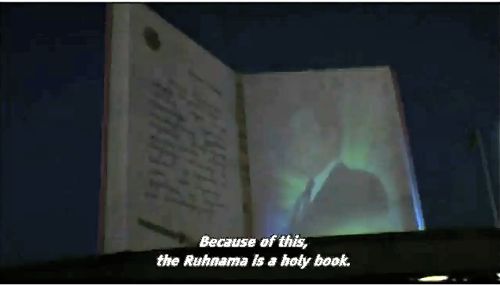
Click to see YouTube video; I’ve punched up this image a little.
This post is part of a series.
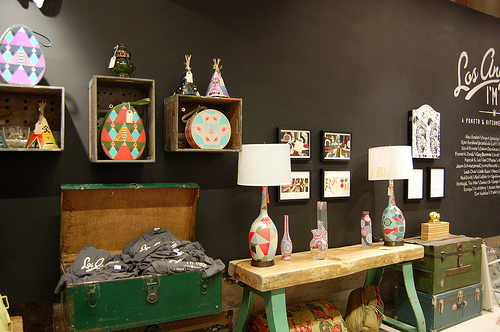
I have to mention this, and only partly because there is a real live Significant Object in the show:
Poketo & Kitsune Noir present: “Los Angeles, I’m Yours”
April 24th until May 15th
Space 15Twenty Gallery, 1520 N. Cahuenga Ave., Los Angeles, CA 90028
From April 24th to May 15th, “Los Angeles I’m Yours” transforms Space 15Twenty Gallery into a living art market. Filled with an eclectic mix of found objects, these vintage pieces are given new life as over 30 artists reinterpret and reincarnate these objects into art.
“Los Angeles, I’m Yours” will create the same joy of the hunt and sensory overload experienced every month at Los Angeles’ famed Rose Bowl outdoor market. Found objects are given new life as an impressive roster of artists will reinterpret and exhibit pieces ranging from vintage glass ware, old vinyl records, antique lamps, and odd knick knacks. Imagine these vintage finds, drawn on, painted on, and manipulated by the artists into a new form.
Posted Under:
Things/Thinking,
To Do
This post was written by Rob Walker on April 26, 2010
Comments Off on Pictures of stuff, cont’d: Flea Market-inspired Art Show

Douglas Coupland:
Last month I installed new bookshelves in a room in my house. They’re black, and my painter offered the unsolicited opinion that they might look depressing when completed. I knew he was wrong because, at the very least, the paperback shelf couldn’t help but have a cheerful orange zing a zing that comes from the Penguin spine, the most wonderfully insidious default interior design statement in our culture.
Of course he’s not simply expressing this opinion in public; it’s part of “A Penguin 75th Anniversary Project By Douglas Coupland.” (Is it just me or has “project” become the trendy word of the moment? Everybody is working a “project” now. Or several “projects.”) This is essentially an appreciation of Penguin cover design, which deserves appreciation: It is, in fact, iconic.
The project, as I understand it, is to use this graphic form (the Penguin cover) as template through which to “speak to the past.” He asks: “How would you speak to someone in the year 1935 from 2010 using a Penguin cover?” Coupland’s answers are here; templates can be downloaded here and people who have done so have added their creations to this Flickr set.
To be honest, I wasn’t really that impressed with any of the results so far. But one of Coupland’s examples (above) caught my eye, and one of the “crowd” submissions (below) caught my eye, and seemed relevant to this series. And, again, I really do think Penguin’s design style is iconic.
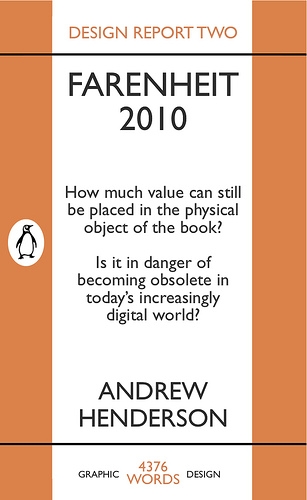
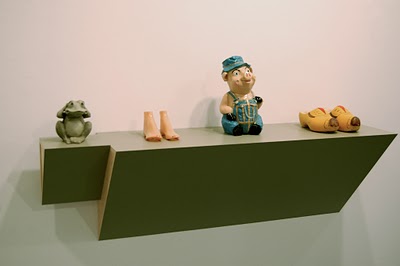
By Haim Steinbach. Click for more.
Once more from the indefatigable Junk Culture:
Haim Steinbach has been an influential exponent of art based on already existing objects. Since the late 1970’s Steinbach’s art has been focused on the selection and arrangement of objects, above all everyday objects.
This post is part of an occasional series.
Posted Under:
Things/Thinking
This post was written by Rob Walker on April 25, 2010
Comments Off on Pictures of Stuff, cont’d: Selection and arrangement
[April 28 2010 update: Some better pictures here. Also, PSFK has picked up on this. But if you read Murketing, you got it here first.]

Here’s something pretty cool: Crystal Chou, a graduate student at the Academy of Art University, San Francisco, will tomorrow present her thesis project, Superluxe. This pop-up window installation will be up from April 26 – May 14 at 74 New Montgomery St., San Francisco.
The Superluxe blog explains:
This design project will take form as a window installation of a one stop shop selling do-it-yourself instant lux branding tools. The shop is intended to poke fun at the elitist luxury industry and demonstrate that anyone can create their own luxury empire based on the current industry’s formulaic branding strategies. Through this satiric commentary, the project encourages that the luxury industry move towards a new humble business model of experimentation and creativity.
Needless to say: This is my kinda thing and I wish I could see it in person. Maybe you can? Here are a couple of Superluxe’s “products”:
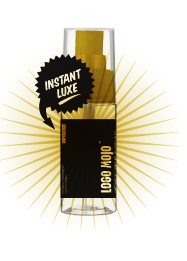 “Logo Mojo and it comes in a form of a spray. It’s a fictitious product that turns a logo into a crazy, fancy, shmancy pattern.”
“Logo Mojo and it comes in a form of a spray. It’s a fictitious product that turns a logo into a crazy, fancy, shmancy pattern.”

“Bling it up is a typical toy vending machine but dispenses capsules filled with diamonds (plastic diamond confetti).”
Other items on the Merchandise List for Superluxe include: Brand In A Bag; Celebrity Endorsement Certificates; Can of Buzz; etc.
If you get to peek at this, please let me know.
Save
 HIT REWIND
HIT REWIND
There is little to be nostalgic for about the cassette tape — except nostalgia itself.
Over the last couple of years, sales of vinyl records increased; the numbers aren’t huge, but they sparked a lot of public musing about the format’s qualities. Cassette sales, meanwhile, steadily dwindled to a mere 34,000 last year through the retail venues tracked by SoundScan. Considering this not long ago, I concluded that the romance associated with vinyl doesn’t apply to its longtime analog rival. I was wrong about that. In looking (and asking) around online, I realize now that there is extensive evidence of ongoing appreciation for the cassette — or at least the idea of the cassette.
Read the column in the April 25, 2010, New York Times Magazine, or here.
And YES, this column is the result of my earlier post on this site, The Idea of The Cassette: THANKS to all who responded to that and alerted me to excellent examples. I am sorry I couldn’t include everything in the column. (Also, for the record: I have zero control over what gets hotlinked on The Times site.)
Discuss, make fun of, or praise this column to the skies at the Consumed Facebook page.




 "
"























 HIT REWIND
HIT REWIND











 Kim Fellner's book
Kim Fellner's book  A
A